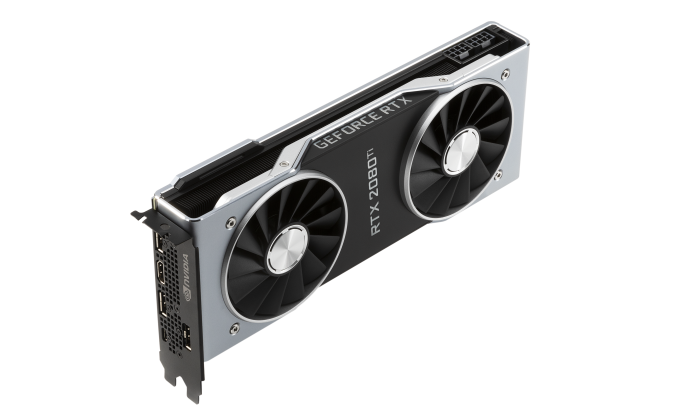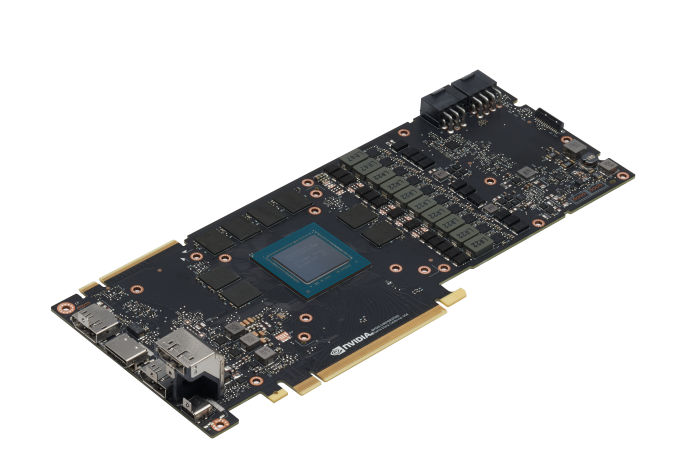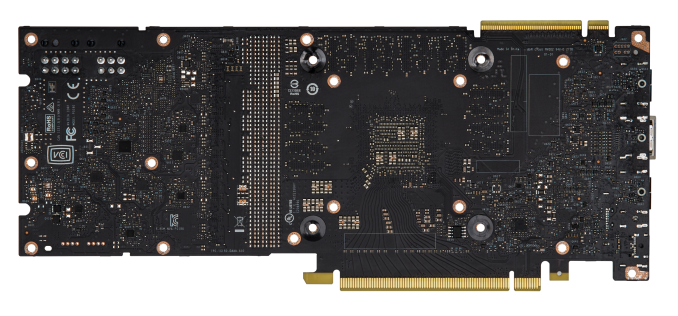The NVIDIA GeForce RTX 2080 Ti & RTX 2080 Founders Edition Review: Foundations For A Ray Traced Future
by Nate Oh on September 19, 2018 5:15 PM EST- Posted in
- GPUs
- Raytrace
- GeForce
- NVIDIA
- DirectX Raytracing
- Turing
- GeForce RTX
Meet The GeForce RTX 2080 Ti & RTX 2080 Founders Editions Cards
Moving onto the design of the cards, we've already mentioned the biggest change: a new open air cooler design. Along with the Founders Edition specification changes, the cards might be considered 'reference' in that they remain a first-party video card sold direct by NVIDIA, but strictly-speaking they are not because they no longer carry reference specifications.
Otherwise, NVIDIA's industrial design language prevails, and the RTX cards bring a sleek flattened aesthetic over the polygonal shroud of the 10 series. The silver shroud now encapsulates an integrated backplate, and in keeping with the presentation, the NVLink SLI connectors have a removable cover.
Internally, the dual 13-blade fans accompany a full-length vapor chamber and component baseplate, connected to a dual-slot aluminum finstack. Looking at improving efficiency and granular power control, the 260W RTX 2080 Ti Founders Edition features a 13-phase iMON DrMOS power subsystem with a dedicated 3-phase system for the 14 Gbps GDDR6, while the 225W RTX 2080 Founders Edition weighing in with 8-phases main and 2-phases memory.
As is typical with higher quality designs, NVIDIA is pushing overclocking, and for one that means a dual 8-pin PCIe power configuration for the 2080 Ti; on paper, this puts the maximum draw at 375W, though specifications-wise the TDP of the 2080 Ti Founders Edition against the 1080 Ti Founders Edition is only 10W higher. The RTX 2080 Founders Edition has the more drastic jump, however, with 8+6 pins and a 45W increase over the 1080's lone 8 pin and 180W TDP. Ultimately, it's a steady increase from the power-sipping GTX 980's 165W.
One of the more understated changes comes with the display outputs, which thanks to Turing's new display controller now features DisplayPort 1.4 and DSC support, the latter of which is part of the DP1.4 spec. The eye-catching addition is the VR-centric USB-C VirtualLink port, which also carries an associated 30W not included in the overall TDP.
Something to note is that this change in reference design, combined with the seemingly inherent low-volume nature of the Turing GPUs, cuts into an often overlooked but highly important aspect of GPU sales: big OEMs in the desktop and mobile space. Boutique system integrators will happily incorporate the pricier higher-end parts but from the OEM’s perspective, the GeForce RTX cards are not just priced into a new range beyond existing ones but also bringing higher TDPs and no longer equipped with blower-style coolers in its ‘reference’ implementation.
Given that OEMs often rely on the video card being fully self-exhausting because of a blower, it would certainly preclude a lot of drop-in replacements or upgrades – at least not without further testing. It would be hard to slot into the standard OEM product cycle at the necessary prices, not to mention the added difficulty in marketing. In that respect, there is definitely more to the GeForce RTX 20 series story, and it’s somewhat hard to see OEMs offering GeForce RTX cards. Or even the RT Cores themselves existing below the RTX 2070, just on basis of the raw performance needed for real time ray tracing effects at reasonable resolutions and playable framerates. So it will be very interesting to see how the rest of NVIDIA’s product stack unfolds.
















337 Comments
View All Comments
whaever85343 - Friday, September 21, 2018 - link
Whatever, this is your new benchmark:https://albertoven.com/2018/08/29/light-lands/
Golgatha777 - Friday, September 21, 2018 - link
I just want to be able to play all my games at 1440p, 60 FPS with all the eye candy turned on. Looks like my overclocked 1080 TI will be good for the immediate future is what I got from this review. The only real upgrade path is to the 2080 TI, and at $1200 that's an extremely hard sell.vivekvs1992 - Friday, September 21, 2018 - link
Well the problem is in India retailers are not willing to reduce the price of 1080 deries.. At present the 2080 is cheaper than all models of 1080 ti.. If given the chance I will definitely go for 2080..thing is that I will have to invest in a gaming monitor firstwebdoctors - Friday, September 21, 2018 - link
Any mining benchmarks?Can I actually make money buying these cards?
ravyne - Friday, September 21, 2018 - link
I agree these are really for early-adopters of RT, or if you're doing a new build or need of a new card but want it to last you 3+ years, so you need to catch the RT wave now.I think the next generation of RT-enabled cards will probably be the optimal entry-point; Presumably they'll be able to double (or so) RT performance on a 7nm process, and that means that the next xx70/80 products will actually have enough RT to match the resolution/framerate expectations of a high-end card, and also that the RT core won't be too costly to put into xx50/60 tier SKUs (If we even see a 2060 SKU, I don't think it will include RT cores at all, simply because the performance it could offer won't really be meaningful).
More than a few things are conspiring against the price too -- Aside from the specter of terriffs, the high price of all kinds of RAM right now, and that this is a 12nm product rather than 7nm, it looks to me like the large and relatively monolithic nature of the RT core itself is preventing nV from salvaging/binning more dies -- with the cuda/tensor cores I'd imagine they build in some redundant units so they can salvage the SM even if there are minor flaws in the functional units, but since there's only 1 RT core per SM, any flaw there means the whole SM is out -- that explains why the 2080 is based on the same GPU as the TI, and why the 2070 is the only card based on the GPU that would normally serve the xx70 and xx80 SKUs. Its possible they might be holding onto the dies with too many flawed RT cores to re-purpose them for the AI market, but that would compete with existing products.
gglaw - Saturday, September 22, 2018 - link
Is there a graph error for BF1 99th percentile at 4k resolution? The 2080 TI FE is at 90, and the 2080 TI (non founders) is 68. How is it possible to have this gigantic difference when almost all other benchmarks and games they are neck and neck?vandamick - Saturday, September 22, 2018 - link
A GTX 980 user. Would the RTX2080 be a big upgrade? Or should I stick with the 1080Ti that I had earlier planned? My upgrade cycle is about 3 years.Inteli - Saturday, September 22, 2018 - link
Are you willing to pay the extra $1-200 for a 2080 over a 1080 Ti for the same performance in current games, in exchange for the new Turing features (Ray-tracing and DLSS)?I'm not convinced yet that the 2080 will be able to run ray-traced games at acceptable frame rates, but it is "more future-proof" for the extra money you pay.
mapesdhs - Thursday, September 27, 2018 - link
Thing is, for the features you're talking about, the 2080 _is not fast enough_ at using them. I don't understand why more people aren't taking this onboard. NVIDIA's own demos show this to be the case, at least for RT. DLSS is more interesting, but the 2080 has less RAM. Until games exist that make decent use of these new features, buying into this tech now when it's at such a gimped low level is unwise. He's far better off with the 1080 Ti, that'll run his existing games faster straight away.AshlayW - Saturday, September 22, 2018 - link
They've completely priced me out of the entire RTX series lol. My budget ends at £400 and even that is pushing it :(